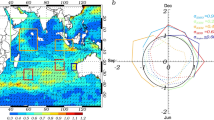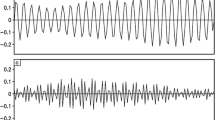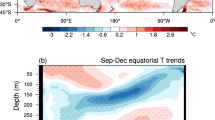Abstract
In this paper, the leading modes of ocean temperature anomalies (OTA) along the equatorial Pacific Ocean are analyzed and their connection with El Niño-Southern Oscillation (ENSO) and interdecadal variation is investigated. The first two leading modes of OTA are connected with the different phases of the canonical ENSO and display asymmetric features of ENSO evolution. The third leading mode depicts a tripole pattern with opposite variation of OTA above the thermocline in the central Pacific to that along the thermocline in the eastern and western Pacific. This mode is found to be associated with so-called ENSO-Modoki. Insignificant correlations of this mode with the first two leading modes suggest that ENSO-Modoki may be a mode that is independent to the canonical ENSO and also has longer time scales compared with the canonical ENSO. The fourth mode reflects a warming (cooling) tendency above (below) the thermocline since 2000. Both the first and second modes have a large contribution to the interdecadal change in thermocline during 1979–2012. Also, the analysis also documents that both ENSO and OTA shifted into higher frequency since 2000 compared with that during 1979–1999. Interestingly, the ENSO-Modoki related OTA mode does not have any trend or significant interdecadal shift during 1979–2012. In addition, it is shown that first four EOF modes seem robust before and after 1999/2000, suggesting that the interdecadal shift of the climate system in the tropical Pacific is mainly a frequency shift and the changes in spatial pattern are relatively small, although the mean states over two periods experienced some significant changes.










Similar content being viewed by others
References
An S-I, Jin F–F (2001) Collective role of thermocline and zonal advective feedbacks in the ENSO mode. J Clim 14:3421–3432
Ashok K, Behera SK, Rao SA, Weng H, Yamagata T (2007) El Niño Modoki and its possible teleconnection. J Geophys Res 112:C11007. doi:10.1029/2006JC003798
Barnett TP, Latif M, Kirk E, Roeckner E (1991) On ENSO physics. J Clim 4(5):487–515
Behringer DW, Xue Y (2004) Evaluation of the global ocean data assimilation system at NCEP: the Pacific Ocean. Preprints, eighth symposium on integrated observing and assimilation systems for atmosphere, oceans, and land surface, Seattle, WA, Amer. Meteor Soc, 2.3 [Available online at http://ams.confex.com/ams/84Annual/techprogram/paper_70720.htm]
Bjerknes J (1969) Atmospheric teleconnections from the equatorial Pacific. Mon Weather Rev 97:163–172
Burgers G, Stephenson DB (1999) The “normality” of El Niño. Geophys Res Lett 26:1027–1030
Clarke AJ, S Van Gorder, Colantuono G (2007) Wind stress curl and ENSO discharge/recharge in the equatorial Pacific. J Phys Ocean: 37(4):1077–1091
Clarke AJ (2010) Analytical theory for the quasi-steady and low-frequency equatorial ocean response to wind forcing: the ‘tilt’ and ‘warm water volume’ modes. J Phys Ocean 40(1):121–137
Collins M et al (2010) The impact of global warming on the tropical Pacific Ocean and El Niño. Nat Geosci 3:391–397. doi:10.1038/ngeo868
Dewitte B, Thual S, Yeh S-W, An S-I, Moon B-K, Giese BS (2009) Low-frequency variability of temperature in the vicinity of the equatorial Pacific thermocline in SODA: role of equatorial wave dynamics and ENSO asymmetry. J Clim 22:5783
Di Lorenzo et al (2010) Central Pacific El Niño and decadal change in the North Pacific Oscillation. Nat Geosci 3 (11). doi:10.1038/NGEO984
Glantz MH (2000) Currents of change: impacts of El Niño and La Niña on climate and society. Cambridge, UK: Cambridge University Press, 266 pp. ISBN 052178672X
Guilyardi E et al (2009) Understanding El Niño in ocean–atmosphere general circulation models: progress and challenges. Bull Am Meteor Soc 90:325–340
Hoerling MP, Kumar A (2002) Atmospheric response patterns associated with tropical forcing. J Clim 15:2184–2203
Horii T, Ueki I, Hanawa K (2012) Breakdown of ENSO predictors in the 2000s: decadal changes of recharge/discharge-SST phase relation and atmospheric intra seasonal forcing. Geophys Res Lett 39:L10707. doi:10.1029/2012GL051740
Hu Z–Z, Kumar A, Jha B, Wang W, Huang B, Huang B (2012) An analysis of warm pool and cold tongue El Niños: air-sea coupling processes, global influences, and recent trends. Clim Dyn 38(9–10):2017–2035. doi:10.1007/s00382-011-1224-9
Hu Z–Z, Kumar A, Ren H-L, Wang H, L’Heureux M, Jin F–F (2013a) Weakened interannual variability in the tropical Pacific Ocean since 2000. J Clim (in press)
Hu Z–Z, A Kumar, Y Xue, B Jha (2013b) Why were some La Niñas followed by another La Niña? Clim Dyn (submitted)
Huang B, Xue Y, Zhang D, Kumar A, McPhaden MJ (2010) The NCEP GODAS ocean analysis of the tropical Pacific mixed layer heat budget on seasonal to interannual time scales. J Clim 23(18):4901–4925
Jin F–F (1997a) An equatorial ocean recharge paradigm for ENSO. Part I: conceptual model. J Atmos Sci 54:811–829
Jin F–F (1997b) An equatorial ocean recharge paradigm for ENSO. Part II: a stripped-down coupled model. J Atmos Sci 54:830–847
Kanamitsu M et al (2002) NCEP-DOE AMIP-II reanalysis (R-2). Bull Am Meteor 83:1631–1643
Kao H-Y, Yu J-Y (2009) Contrasting eastern-Pacific and central-Pacific types of ENSO. J Clim 22:615–632
Kessler WS (2002) Is ENSO a cycle or a series of events? Geophys Res Lett 29(23):2125. doi:10.1029/2002GL015924
Kim ST, Yu J-Y, Kumar A, Wang H (2012) Central-Pacific El Niño in the NCEP CFS model and its extratropical associations. Mon Weather Rev 140:1908–1923
Kug J-S, Jin F–F, An S-I (2009) Two types of El Niño events: cold tongue El Niño and warm pool El Niño. J Clim 22:1499–1515. doi:10.1175/2008JCLI2624.1
Kug J-S, Choi J, An S-I, Jin F–F, Wittenberg AT (2010) Warm pool and cold tongue El Niño events as simulated by the GFDL 2.1 coupled GCM. J Clim 23:1226–1239
Kumar A, Zhang Q, Peng P, Jha B (2005) SST-forced atmospheric variability in an atmospheric general circulation model. J Clim 18:3953–3967
Kumar A, Chen M, Zhang L, Wang W, Xue Y, Wen W, Marx L, Huang B (2012) An analysis of the nonstationarity in the bias of sea surface temperature forecasts for the NCEP climate forecast system (CFS) version 2. Mon Weather Rev 140: 3003–3016. http://dx.doi.org/10.1175/MWR-D-11-00335.1
L’Heureux M, Collins D, Hu Z–Z (2013) Linear trends in sea surface temperature of the tropical Pacific Ocean and implications for the El Niño-Southern Oscillation. Clim Dyn 40(5–6):1223–1236. doi:10.1007/s00382-012-1331-2
McPhaden MJ (1993) TOGA-TAO and the 1991–93 El Niño Southern Oscillation event. Oceanography 6(2):36–44
McPhaden MJ (2012) A 21st century shift in the relationship between ENSO SST and warm water volume anomalies. Geophys Res Lett 39:L09706. doi:10.1029/2012GL051826
McPhaden MJ, Lee T, McClurg D (2011) El Niño and its relationship to changing background conditions in the tropical Pacific Ocean. Geophys Res Lett 38:L15709. doi:10.1029/2011GL048275
Meinen CS, McPhaden MJ (2000) Observations of warm water volume changes in the equatorial Pacific and their relationship to El Niño and La Niña. J Clim 13:3551–3559
Moon B-K et al (2004) Vertical structure variability in the equatorial Pacific before and after the Pacific climate shift of the 1970s. Geophys Res Lett 31(3):L03203. doi:10.1029/2003GL018829
National Research Council (2010) Assessment of intraseasonal to interannual climate prediction and predictability. The National Academies Press: Washington, 192 pp. ISBN-10: 0-309-15183-X
Neelin JD et al (1998) ENSO theory. J Geophys Res 103:14261–14290
Okumura YM, Deser C (2010) Asymmetry in the duration of El Niño and La Niña. J Clim 23:5826–5843
Okumura YM, Ohba M, Deser C, Ueda H (2011) A proposed mechanism for the asymmetric duration of El Niño and La Niña. J Clim 24:3822–3829. doi:10.1175/2011JCLI3999.1
Philander SGH (1990) El Niño, La Niña and the Southern Oscillation. Academic Press, San Diego, 293 pp. ISBN 0125532350
Picaut J, Ioualalen M, Menkes C, Delcroix T, McPhaden MJ (1996) Mechanism of the zonal displacements of the Pacific warm pool: implications for ENSO. Science 274:1486–1489
Ropelewski C, Halpert M (1987) Global and regional scale precipitation patterns associated with the El Niño-Southern Oscillation. Mon Weather Rev 115:1606–1626
Smith TM, Reynolds RW, Peterson TC, Lawrimore J (2008) Improvements to NOAA’s historical merged land-ocean surface temperature analysis (1880–2006). J Clim 21:2283–2296
Trenberth KE, Smith L (2006) The vertical structure of temperature in the tropics: different flavors of El Niño. J Clim 19:4956–4973
Vimont DJ, Alexander M, Fontaine A (2009) Mid-latitude excitation of tropical variability in the Pacific: the role of thermodynamic coupling and seasonality. J Clim 22:518–534
Wang C, Picaut J (2004) Understanding ENSO physics—a review. Earth’s climate: the ocean-atmosphere interaction. In: C Wang, S-P Xie, JA Carton (Eds.) AGU Geophys Monogr Ser, 147: 21–48
Wang W, Chen M, Kumar A (2010) An assessment of the CFS real-time seasonal forecasts. Weather Forecast 25:950–969. doi:10.1175/2010WAF2222345.1
Weare BC, Navato AR, Newell RE (1976) Empirical orthogonal analysis of Pacific sea surface temperatures. J Phys Ocean 6:671–678
Xue Y, Chen M, Kumar A, Hu Z–Z, Wang W (2013) Prediction skill and bias of tropical Pacific sea surface temperatures in the NCEP climate forecast system version 2. J Clim (in press)
Yu J-Y, Kao H-Y, Lee T, Kim ST (2011) Subsurface ocean temperature indices for Central-Pacific and Eastern-Pacific types of El Niño and La Niña events. Theor Appl Clim 103(3–4):337–344. doi:10.1007/s00704-010-0307-6
Zhang R-H, Levitus S (1996) Structure and evolution of interannual variability of the tropical Pacific upper ocean temperature. J Geophys Res 101:20501–20524
Zhang R-H, Levitus S (1997) Interannual variability of the coupled tropical Pacific ocean-atmosphere system associated with the El Nino/Southern Oscillation. J Clim 10:1312–1330
Acknowledgments
We thank the TAO Project Office of NOAA/PMEL for supplying the TAO data, and appreciate the constructive comments of two reviewers as well as Drs. Wanqiu Wang, Yan Xue, and Hui Wang.
Author information
Authors and Affiliations
Corresponding author
Rights and permissions
About this article
Cite this article
Kumar, A., Hu, ZZ. Interannual and interdecadal variability of ocean temperature along the equatorial Pacific in conjunction with ENSO. Clim Dyn 42, 1243–1258 (2014). https://doi.org/10.1007/s00382-013-1721-0
Received:
Accepted:
Published:
Issue Date:
DOI: https://doi.org/10.1007/s00382-013-1721-0




